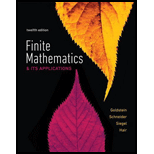
Population Dynamics
In 1991, the U.S. Fish and Wildlife Service proposed logging restrictions on nearly 12 million acres of Pacific Northwest forest to help save the endangered northern spotted owl. This decision caused considerable controversy between the logging industry and environmentalists.
Mathematical ecologists created a mathematical model to analyze the population dynamics of the spotted owl. They divided the female owl population into three categories: juvenile (up to 1 year old), subadult (1 to 2 years old), and adult (over 2 years old). Suppose that in a certain region there are currently 2950 female spotted owls made up of 650 juveniles, 200 subadults, and 2100 adults. The ecologists used matrices to project the changes in the population from year to year. The original numbers can be displayed in the column matrix
The populations after one year are given by the column matrix
The subscript 1 tells us that the matrix gives the population after one year. The names of the matrices for subsequent years will have subscripts 2, 3, 4, etc.
Fill in the blanks in the following statements.
(a) Each year, _____juvenile females are born for each 100 adult females.
(b) Each year, _____% of the juvenile females survive to become subadults.
(c) Each year, _____% of the subadults survive to become adults and _____ % of the adults survive.
Want to see the full answer?
Check out a sample textbook solution
Chapter 2 Solutions
Finite Mathematics & Its Applications (12th Edition)
- Refer to page 34 for deriving and applying Pontryagin's Maximum Principle. Instructions: ⚫ Define the Hamiltonian for the given control problem. • • Derive the necessary conditions for optimality step-by-step, including state and co-state equations. Solve the resulting system of equations explicitly, showing all intermediate steps. Link: [https://drive.google.com/file/d/1wKSrun-GlxirS31Z9qoHazb9tC440AZF/view?usp=sharing]arrow_forwardRefer to page 20 for solving a separable differential equation. Instructions: ⚫ Separate the variables explicitly. • Integrate both sides carefully, showing intermediate steps. • Simplify the final result and provide the explicit or implicit solution as required. Link: [https://drive.google.com/file/d/1wKSrun-GlxirS31Z9qoHazb9tC440AZF/view?usp=sharing]arrow_forwardRefer to page 16 for a problem involving solving a second-order linear homogeneous differential equation. Instructions: • Analyze the characteristic equation and address all possible cases (distinct, repeated, and complex roots). • Show detailed steps for deriving the general solution. • Verify solutions by substitution into the original equation. Link: [https://drive.google.com/file/d/1wKSrun-GlxirS31Z9qoHazb9tC440AZF/view?usp=sharing]arrow_forward
- Need help with question?arrow_forwardNeed help with question?arrow_forwardRefer to page 15 for a problem involving evaluating a double integral in polar coordinates. Instructions: Convert the given Cartesian integral to polar coordinates. Show all transformations and step-by-step calculations. Link [https://drive.google.com/file/d/1wKSrun-GlxirS31Z9qoHazb9tC440AZF/view?usp=sharing]arrow_forward
- Refer to page 9 for a problem requiring finding the tangent plane to a given surface at a point. Instructions: Use partial derivatives to calculate the equation of the tangent plane. Show all calculations step-by-step. Link [https://drive.google.com/file/d/1wKSrun-GlxirS31Z9qoHazb9tC440AZF/view?usp=sharing]arrow_forwardRefer to page 8 for a problem involving solving a second-order linear homogeneous differential equation. Instructions: Solve using characteristic equations. Show all intermediate steps leading to the general solution. Link: [https://drive.google.com/file/d/1wKSrun-GlxirS3IZ9qoHazb9tC440AZF/view?usp=sharing]arrow_forwardRefer to page 17 for a problem requiring solving a nonlinear algebraic equation using the bisection method. Instructions: Show iterative calculations for each step, ensuring convergence criteria are satisfied. Clearly outline all steps. Link [https://drive.google.com/file/d/1wKSrun-GlxirS31Z9qo Hazb9tC440AZF/view?usp=sharing]arrow_forward
- Problem: The probability density function of a random variable is given by the exponential distribution Find the probability that f(x) = {0.55e−0.55x 0 < x, O elsewhere} a. the time to observe a particle is more than 200 microseconds. b. the time to observe a particle is less than 10 microseconds.arrow_forwardThe OU process studied in the previous problem is a common model for interest rates. Another common model is the CIR model, which solves the SDE: dX₁ = (a = X₁) dt + σ √X+dWt, - under the condition Xoxo. We cannot solve this SDE explicitly. = (a) Use the Brownian trajectory simulated in part (a) of Problem 1, and the Euler scheme to simulate a trajectory of the CIR process. On a graph, represent both the trajectory of the OU process and the trajectory of the CIR process for the same Brownian path. (b) Repeat the simulation of the CIR process above M times (M large), for a large value of T, and use the result to estimate the long-term expectation and variance of the CIR process. How do they compare to the ones of the OU process? Numerical application: T = 10, N = 500, a = 0.04, x0 = 0.05, σ = 0.01, M = 1000. 1 (c) If you use larger values than above for the parameters, such as the ones in Problem 1, you may encounter errors when implementing the Euler scheme for CIR. Explain why.arrow_forwardRefer to page 1 for a problem involving proving the distributive property of matrix multiplication. Instructions: Provide a detailed proof using matrix definitions and element-wise operations. Show all calculations clearly. Link [https://drive.google.com/file/d/1wKSrun-GlxirS3IZ9qoHazb9tC440AZF/view?usp=sharing]arrow_forward
 Linear Algebra: A Modern IntroductionAlgebraISBN:9781285463247Author:David PoolePublisher:Cengage Learning
Linear Algebra: A Modern IntroductionAlgebraISBN:9781285463247Author:David PoolePublisher:Cengage Learning

